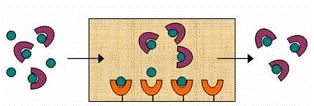Chemistry, Department of: Faculty Series

David Hage Publications
Document Type
Article
Date of this Version
2009
Abstract
Silica monoliths in affinity microcolumns were tested for the high-throughput analysis of drug–protein interactions. HSA was used as a model protein for this work, while carbamazepine and R-warfarin were used as model analytes. A comparison of HSA silica monoliths of various lengths indicated columns as short as 1 to 3 mm could be used to provide reproducible estimates of retention factors or plate heights. Benefits of using smaller columns for this work included the lower retention times and lower back pressures that could be obtained versus traditional HPLC affinity columns, as well as the smaller amount of protein that is required for column preparation. One disadvantage of decreasing column length was the lower precision that resulted in retention factor and plate height measurements. A comparison was also made between microcolumns containing silica particles versus silica monoliths. It was demonstrated with R-warfarin that supports could be used in HSA microcolumns for the determination of retention factors or plate heights. However, the higher efficiency of the silica monolith made this the preferred support for work at higher flow rates or when a larger number of plates are needed during the rapid analysis of drug–protein interactions.


Comments
Published in Journal of Separation Science 32 (2009), pp. 2776–2785; doi: 10.1002/jssc.200900346 Copyright © 2009 WILEY-VCH Verlag GmbH & Co. KGaA, Weinheim. Used by permission.